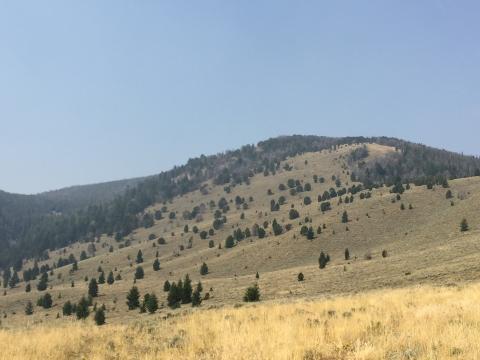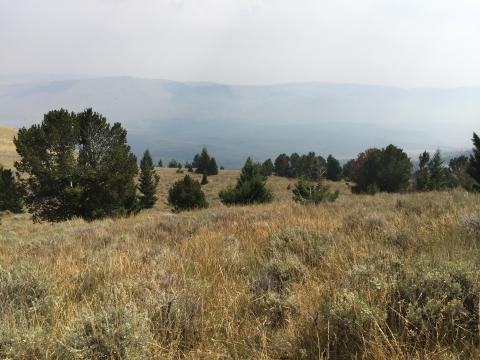Whitebark pine encroachment into lower elevation sagebrush grasslands in southwest Montana, USA
Projections for future whitebark pine habitat under changing climate conditions predominantly predict that the species will have a smaller ecological niche than they currently inhabit, with most of the population encapsulated in small, high elevation sites. However, there is evidence of whitebark pine populations at lower elevational levels during warmer periods with more frequent fire regimes (Arno 1993), and the current changing climate conditions and increased fire activity on the landscape may provide for better microsite conditions for seedling establishment. Substantiating that whitebark pine is continuing to regenerate and grow at lower elevations indicates that we have an incomplete understanding of what will drive tree regeneration and growth dynamics into our uncertain future and serves as evidence of that uncertainty in climate change vegetation response projections.
Sites were opportunistically chosen within southwest Montana by driving and hiking through areas where encroachment was suspected. At each site, a seed source stand of mature whitebark pine was located with visible encroachment into lower elevation sagebrush grasslands below the stand and no encroachment into upper grassland areas. Stand level data was collected in the seed source stand from 5 macroplots (1/10th acre in size). We then installed 100 m belt transect running downhill into the sagebrush grassland and uphill into the subalpine meadow. Each belt transect was 100 meters wide and at least 100 meters long following the shape of the stand. Within these transects, we tallied all whitebark pine seedlings by 25 cm height classes. For all trees above 1.37 meters tall, we recorded species and measured DBH, height, CBH, percent crown killed by blister rust, and age. We also recorded GPS coordinates for these trees. Age was estimated for the trees above 1.37 meters in height within the belt transects from increment cores that were extracted as close to ground level as possible. Rings were easily counted in the field due to the vigorous growth of the whitebark pine trees.
In this limited case study, we found whitebark pine encroachment into non-forested areas only occurred downslope into the drier, warmer sagebrush grasslands rather than upslope into the cooler, moister subalpine meadows. We found that not only were substantial amounts of whitebark pine regenerating downslope in the sagebrush grasslands, but the sampled individual trees were healthy and thriving as evidenced by the large height growth increments, pitch exudations from growth cracks at branch origins near the bole, and large diameters for the young tree ages. Some of the young trees were producing numerous cones at an early age (<50 yr), which is in contrast to the first cone production ages of 60 years documented by Arno and Hoff (1990).We also found that encroachment occurred over the last 100 years and did not occur as a pulse but rather as a gradual increase as evidenced by the wide span in ages and sizes of whitebark pine trees in the non-forest area.


